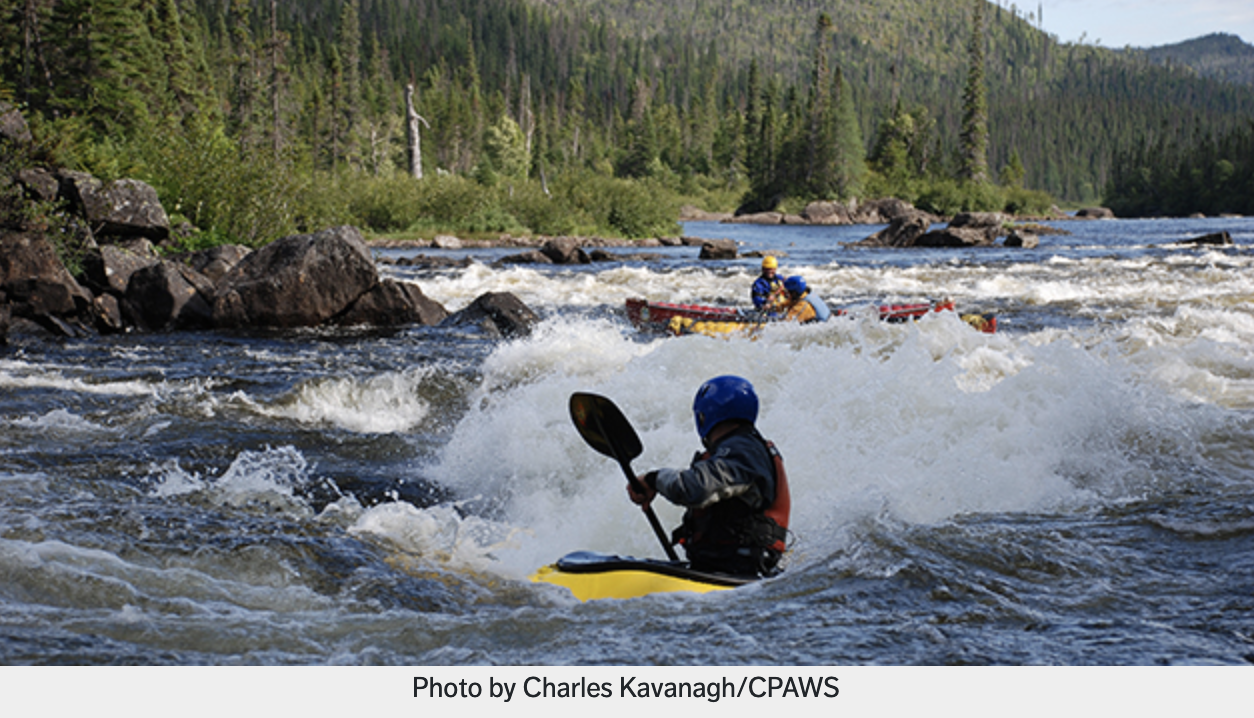This opinion piece by Patrick Barkham appeared in The Guardian on July 25, 2021.
Around the world, activists are pushing to protect their rivers by giving them legal personhood. Is this just symbolism, or can it drive lasting environmental change?
The Magpie River winds majestically through the forests of Quebec for nearly 200 miles. Its thundering ribbon of blue is cherished by kayakers, white-water rafters and the indigenous Innu people of Ekuanitshit. Earlier this year, in a first for Canada, the river was granted legal personhood by local authorities, and given nine rights, including the right to flow, the right to be safe from pollution – and the right to sue.
Uapukun Mestokosho, a member of the Innu community who campaigned for the recognition of the Magpie’s rights said spending time on the river was “a form of healing” for indigenous people who could revive their traditional land-based practices that had been abandoned during the violence of the colonial era. “People are suffering a lot, with intergenerational traumas linked to the past,” Mestokosho told CBC. As well as this benefit for people, she said that her ancestors had always protected the Magpie, known as the Muteshekau-shipu, in the past, and a recognition of its rights would help protect it for future generations.
The Magpie is one of a growing number of rivers to be recognised as a living entity across the world. The burgeoning rights-of-nature movement is pushing local, national and international authorities to recognise natural features – from lakes to mountains – in law, giving them either legal personhood or an independent right to flourish.
Giving rivers the status of people – or more – in courts of law is enlivening environmentalism around the world. Ecuador started the movement when it enshrined rights of nature in its constitution in 2008. Countries such as Bolivia, Mexico and Colombia have created comparable legal mechanisms to protect nature, while New Zealand, Australia and Bangladesh have acted to protect rivers. In the United States, residents of Toledo drew up a bill of rights for Lake Erie. But can legal rights for nature protect it in reality? Who decides when a river can sue? Does it diminish the power of nature to squeeze it into the western legal system? Or do nature’s rights challenge the very foundations of capitalism?
Western legal thinkers began probing the prevalent Enlightenment assumption that natural objects were simply property to be exploited in 1972 when a young professor of legal philosophy, Christopher Stone, argued that the environment should be considered as a subject and given legal personhood – as granted to corporations, for instance – with human guardians able to seek legal redress if a natural feature is damaged or destroyed. Today’s movement was ignited in 2017 when an act of parliament in New Zealand granted the whole Whanganui River rights as an independent entity, considering it an indivisible whole from source to sea. This was part of the treaty settlement between the government and the Māori people. Guardians were appointed to act and speak on behalf of the river and enforce its rights.
But what is a river? Most would say not its banks but its flowing water. Unfortunately, the “elephant in the room,” says Dr Erin O’Donnell of the University of Melbourne and author of a book on rights for rivers, is the fact that none of the rivers legally recognised as living beings or legal persons actually have any rights to the water that flows within their banks.
“There is increasingly an attempt to give rivers a right to flow and so the Magpie River in Canada has got the right to flow, but how you enforce that right is very unclear,” says O’Donnell. “And if that’s not actually embedded within water law, which it isn’t yet, then it’s probably not worth the paper it’s written on.”
In New Zealand, the Whanganui treaty did not address this key issue, with a water company continuing to divert 80% of the river’s flow for hydropower until its licence expires in 2039. If this fact makes rights for rivers appear to be symbolism without legal teeth, O’Donnell and others argue that the concept still possesses real transformative power. In Canada, David Boyd, a professor of law and the UN Special Rapporteur on Human Rights and Environment, has said that legal personhood could succeed where decades of environmental laws have failed, kickstarting a cultural shift away from conceiving of nature as a “warehouse of commodities for human use”.
In Australia, that shift is underway with regards to the Yarra, believes O’Donnell. The Yarra was recognised as a living, integrated entity as its traditional owners, the Wurundjeri people, had always known it, in a state act of parliament in 2017. Unlike Lake Erie and other locations in North America, the Yarra has not been made a legal person. “The upside of having legal personality is that you do have extra legal powers, so a river that is a legal person can go to court. The downside is that you immediately focus people’s attention on those rights and powers and expect the river to start using them,” says O’Donnell. “One of the first questions that I get asked almost every time I speak publicly about the issue of rivers having rights is, ‘Can we sue the river when it floods?’” As soon as Lake Erie was granted rights in the United States, farmers – concerned that measures to stop fertilisers running into the lake would threaten their businesses – challenged it in court.
Having the Yarra recognised as a living entity sounds like a weaker step than legal personhood, but it still has “the most transformative potential in terms of the way that people relate to the river,” argues O’Donnell. Until very recently, the river was a resource to exploit: a source of water, a stormwater drain and a sewer. “When we see the river as a living being, is that when we start to say, hang on, what do we want for the river? That’s the genuine conversational shift I’m seeing with the Yarra away from this western resource extraction model to seeking a partnership with the river in its own management.”
Some rights-of-nature sceptics argue that it simply can’t fit into western law, which upholds capitalism, property rights and extracting profit from the Earth’s resources. After Ecuador incorporated rights of nature into its constitution, in 2011 a provincial court ruled in favour of the Vilcabamba River against damaging road construction. The river won in court but the developer didn’t actually take the action required to remediate the pollution. Ecuador’s courts have since held more than three dozen lawsuits in the name of nature. Many have been successful but verdicts have not always been enforced on the ground.
In India, a state high court tried to give the Ganges and Yamuna River legal personhood in 2017, but the decision was appealed to the supreme court. Campaigners are still waiting for the verdict while the rivers continue to be polluted and exploited…
Read the full article HERE.

